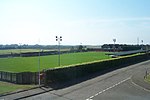Kelty
KeltyMining communities in FifeTowns in FifeUse British English from June 2015

Kelty (Scottish Gaelic: Cailtidh) is a former coal mining village located in Fife, Scotland. Lying in the heart of the old mining heartlands of Fife, it is situated on the Fife/Kinross-shire boundary and has a population of around 6,000 residents. This was nearer to 9,000 when the coal mining industry was still operational in late 1970s and early 1980s.
Excerpt from the Wikipedia article Kelty (License: CC BY-SA 3.0, Authors, Images).Kelty
Main Street,
Geographical coordinates (GPS) Address Nearby Places Show on map
Geographical coordinates (GPS)
| Latitude | Longitude |
|---|---|
| N 56.133 ° | E -3.38 ° |
Address
Main Street
KY4 0AA
Scotland, United Kingdom
Open on Google Maps








